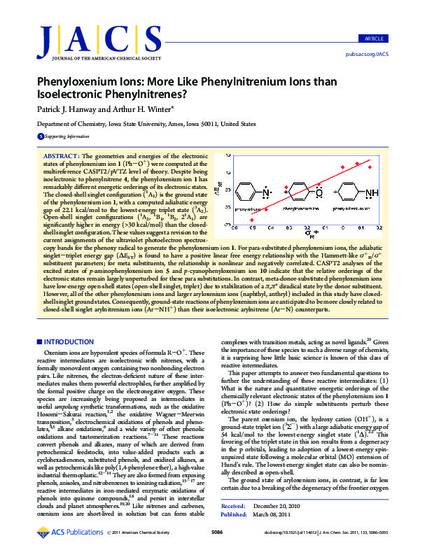
The geometries and energies of the electronic states of phenyloxenium ion 1 (Ph−O+) were computed at the multireference CASPT2/pVTZ level of theory. Despite being isoelectronic to phenylnitrene 4, the phenyloxenium ion 1 has remarkably different energetic orderings of its electronic states. The closed-shell singlet configuration (1A1) is the ground state of the phenyloxenium ion 1, with a computed adiabatic energy gap of 22.1 kcal/mol to the lowest-energy triplet state (3A2). Open-shell singlet configurations (1A2, 1B1, 1B2, 21A1) are significantly higher in energy (>30 kcal/mol) than the closed-shell singlet configuration. These values suggest a revision to the current assignments of the ultraviolet photoelectron spectroscopy bands for the phenoxy radical to generate the phenyloxenium ion 1. For para-substituted phenyloxenium ions, the adiabatic singlet−triplet energy gap (ΔEST) is found to have a positive linear free energy relationship with the Hammett-like σ+R/σ+ substituent parameters; for meta substituents, the relationship is nonlinear and negatively correlated. CASPT2 analyses of the excited states of p-aminophenyloxenium ion 5 and p-cyanophenyloxenium ion 10 indicate that the relative orderings of the electronic states remain largely unperturbed for these para substitutions. In contrast, meta-donor-substituted phenyloxenium ions have low-energy open-shell states (open-shell singlet, triplet) due to stabilization of a π,π* diradical state by the donor substituent. However, all of the other phenyloxenium ions and larger aryloxenium ions (naphthyl, anthryl) included in this study have closed-shell singlet ground states. Consequently, ground-state reactions of phenyloxenium ions are anticipated to be more closely related to closed-shell singlet arylnitrenium ions (Ar−NH+) than their isoelectronic arylnitrene (Ar−N) counterparts.
Available at: http://works.bepress.com/arthur_winter/11/

Reprinted (adapted) with permission from J. Am. Chem. Soc., 2011, 133 (13), pp 5086–5093. Copyright 2011 American Chemical Society.